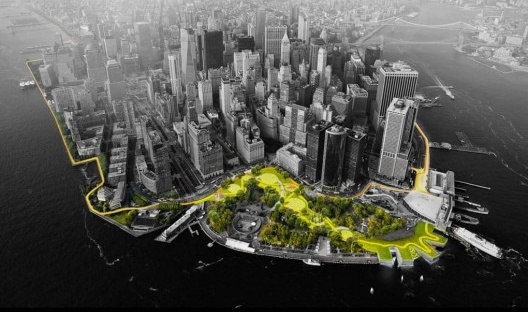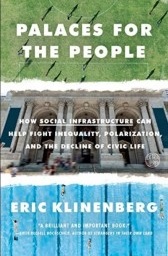Aiming to analyze and showcase ways in which we can help society build civic life, the book starts with a study case of the Chicago heat wave that happened between July 12th to July 20th in 1995. In this period, “739 people in excess of the norm died in Chicago” due to heat related illnesses. His analysis shows the differences between poor and rich neighborhoods death indexes: because of the lack of access to cooling amenities, mainly air-conditioning, the poor neighborhoods were the ones that suffered the most. Among poor neighborhoods, the mainly African-American communities were the most affected. Despite that, an interesting pattern called out the author attention: some of the poor African-American neighborhoods with the same density of the others showed more resilience during this hard situation. Looking at data and comparing it, Klinenberg wasn’t able to find which factor contributed to this outcome, but when he decided to take a look on the physical conditions of these neighborhoods, he had a clear view of the disparity. The most affected communities were the ones with bad public environment, containing damaged sidewalks, little commerce spots and low public engage in community associations. Meanwhile, the ones that showed resilience had the opposite aspects. The main factor on the existence of resilience was the fact that the public environment was key to nourish residents’ interactions and create community vigilance towards the most vulnerable.
These public spaces, named by the author as Social Infrastructure, are in his perspective the main factor that contributes to a resilient and tolerant society. In a time of divisions, such as seen in the 2016 elections in the United States and throughout the world, creating bounds among different classes are an important target to strive a nourishing society.
The author continues with a storytelling about his experience in a virtual bowling club from New York, which happens in an underground public library. This activity performs a crucial role in the life of older people from the neighborhood. The author explains how important public libraries are for the community life in the United States. Despite that, the author points out that libraries have been underfund in the past years because public administration often see these systems as unnecessary due to the fact that its main purpose, which is to provide books, can easily be substituted for online platforms.
Libraries can provide many activities to a big and heterogeneous group of people like children, teenagers and college students but also to mothers and older people from different backgrounds. The role of this institution goes far beyond providing books: it can be a quiet and safe space to gather, study, read and socialize. Many social groups see it as a place to meet and entertain.
Despite that, the social infrastructure that a community library can build is not enough to make an environment safe or prevent crime. Other theories have been used to try to understand crime patterns. Some of them are place-based and not people-based as usually is seen. In the “broken windows” theory - one of the first to be published - the researchers claim that the maintenance of the public space or the lack of it is key to determine whether the area will have crime incidence of not. In spite of being well accepted by a big public, the author questions the way this theory has been interpreted by policy makers and also students and academic members. In his perception, the neighborhoods’ superficial appearance and if it has graffiti or broken windows (which named the theory itself), have very little influence on crime incidence. Looking to get further details, the author gathered with other researchers to make an experiment and collect data about this theory. What they discovered is that empty plots with no maintenance or empty houses are much more in charge of crime incidence. The reasoning behind it is because they offer an actual place for crimes such as drug dealing to happen because they have spots where criminals can hide. The experiment was taken in poor violent neighborhoods in different cities. Their main task was to give a treat on the empty plots and houses in order to monitor the impact it had. With doing so, the crime rate around these areas that had the intervention fell drastically. Although it not only has to do with appearance, this experience reinforces the fact that the environment has a big role on how safe a place is.
Another discussion brought by the author is the gentrification caused by new developments. Even though it can bring the “Eyes on the streets” that the American author Jane Jacobs claims to be an important factor on streets safety, it can come at the expense of expelling the local residents. This is even worse in black communities where the residents can be more affected by gentrification.
The access to good quality food is another topic discussed in the book. It is much more difficult to find fresh food in low-income communities than in the high-income ones. The lack of access to fresh quality food may happen because of two reasons. The first one is related to the scarce options of these markets close to low-income communities. This fact forces the residents to leave their neighborhoods in order to find these goods. The second reason is due to the inaccessible prices charged for such items, making the low-income families not able to afford them. Many initiatives are bringing back the city farms concept to grow food in urban empty lots. Not only they represent a first step to help communities get access to these products, they also to offer a public space for gathering and a green space to the neighborhood.
The green spaces in cities are also responsible for health disparities. In the city of Los Angeles, more affluent neighborhoods with better maintained public spaces for leisure and recreation are the main reason why their users have lower obesity and anxiety levels. This shows that these spaces are very important to keep their communities healthy. Despite that, poorer neighborhoods in the same city are the opposite of these ones.
Social infrastructure is also helpful when it comes to dangerous situations. When hurricanes hit the United States in the past, one of the crucial points for residents to escape life threatening situations were their connections to their neighbors. This served as a support system that made it possible for families to find safer shelters when needed. Infrastructure investments aiming to mitigate the impact of natural catastrophes such as hurricanes and rainstorms are a very important matter, especially in coastal areas where their impact can be much worse. Many cities across the globe have been taking serious actions to implement these systems. Some of these cities have taken the smart path and aligned their projects to be both a protection asset and a space for public entertainment. The city of New York has one of the most ambitious ones. Designed by the office of star architect Bjarke Ingels, the project is a U-shaped belt around lower Manhattan which integrates a water drain system to a public park in the same space.
As a final topic to the book, the author points out two important matters related to social media, the new way our society has been socializing. He first points out a letter from Facebook CEO Mark Zuckerberg on the company commitment to improve online social gathering for groups with the same interests. The letter also shows the institution’s support to foster their actions and engage more people through Facebook. While Zuckerberg shows his concerns about the negative impact of Facebook on face-to-face interactions, companies like his’ have been the great pivots on the gentrification that goes on in the Silicon Valley. It also affects the roles that civic institutions and public spaces have in the American society. Not only do their presence attracts wealthy workers and push housing prices to the sky, some of these companies even have their own buses to help their employees avoid traffic. It shows a clear message that they are very interested in solving their own problems. At last, Facebook also played a major role on the 2016 elections in the United States by receiving money from political advertising. The institution let some data be used by Russians companies to advocate against Democrat candidate Hillary Clinton aiming to benefit Donald Trump. This is a very significant and clear evidence of the power that social media have on shaping individuals’ decisions and behaviors.
The book is a mix of storytelling and technical information on experiences that shape both cities' public spaces and its social life. The author uses real experiments as examples to describe the impacts that some social infrastructures can have on crime and death rates related to environmental issues. It illustrates how the environment is determinant to foster the social life and how it can help cities understand and stimulate many of the citizen’s issues, such as public security, health, social connections and others.
about the author
Aline Amorim Bolis is an architect by the Graduate Course in Architecture and Urbanism, Center for Applied Social Sciences at the Dom Bosco Catholic University – UCDB, 2018.
Bruno Alves dos Santos is graduated in Architecture and Urbanism, Center for Applied Social Sciences at the Dom Bosco Catholic University - UCDB, 2020.






